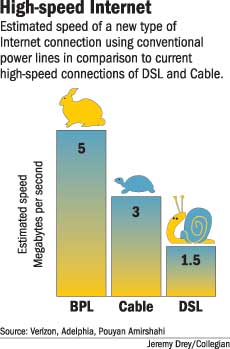Margo Brown (sophomore-advertising and English) said she feels spoiled because she has high-speed Internet in her dorm.
That's because Brown is from Dushore, a rural area about an hour west of Scranton, and she has to use dial-up to connect to the Internet at home, she said.
"When I go home, I can't be online for long and download music," she said. "It's a pain."
For those students like Brown who don't have access to high-speed Internet at home, a new technology using existing power lines that is currently being researched by Penn State engineers could change that.
Mohsen Kavehrad, W.L. Weiss professor of electrical engineering and director for the Center for Information and Communications Technology Research, and Pouyan Amirshahi (graduate-electrical engineering) have created a model for broadband over power line (BPL).
BPL is an alternative to high-speed Internet connections such as Digital Subscriber Lines (DSL) and cable, Amirshahi said.
In theory, their research based on computer simulations shows it is possible to get a gigabit per second on a medium-voltage power line using BPL, Kavehrad said.
This compares with about 1.5 megabits per second (Mbps) on DSL connections and two to three Mbps on cable connections, although speeds can vary with each line, according to Verizon's and Adelphia's Web sites. There are 1,000 megabits in one gigabit.
Amirshahi said his cable Internet service in State College connects around one Mbps.
"BPL can deliver at least four to five Mbps to an individual house," he said.




